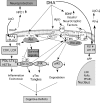DHA may prevent age-related dementia
- PMID: 20181786
- PMCID: PMC2838628
- DOI: 10.3945/jn.109.113910
DHA may prevent age-related dementia
Abstract
The risk for dementia, a major contributor to incapacitation and institutionalization, rises rapidly as we age, doubling every 5 y after age 65. Tens of millions of new Alzheimer's disease (AD) and other dementia cases are projected as elderly populations increase around the world, creating a projected dementia epidemic for which most nations are not prepared. Thus, there is an urgent need for prevention approaches that are safe, effective, and affordable. This review addresses the potential of one promising candidate, the (n-3) fatty acid docosahexaenoic acid (DHA), which appears to slow pathogenesis of AD and possibly vascular dementia. DHA is pleiotropic, acting at multiple steps to reduce the production of the beta-amyloid peptide, widely believed to initiate AD. DHA moderates some of the kinases that hyperphosphorylate the tau-protein, a component of the neurofibrillary tangle. DHA may help suppress insulin/neurotrophic factor signaling deficits, neuroinflammation, and oxidative damage that contribute to synaptic loss and neuronal dysfunction in dementia. Finally, DHA increases brain levels of neuroprotective brain-derived neurotrophic factor and reduces the (n-6) fatty acid arachidonate and its prostaglandin metabolites that have been implicated in promoting AD. Clinical trials suggest that DHA or fish oil alone can slow early stages of progression, but these effects may be apolipoprotein E genotype specific, and larger trials with very early stages are required to prove efficacy. We advocate early intervention in a prodromal period with nutrigenomically defined subjects with an appropriately designed nutritional supplement, including DHA and antioxidants.
Figures

Similar articles
-
Dietary fatty acids and the aging brain.Nutr Rev. 2010 Dec;68 Suppl 2(0 2):S102-11. doi: 10.1111/j.1753-4887.2010.00345.x. Nutr Rev. 2010. PMID: 21091943 Free PMC article. Review.
-
Omega-3 fatty acids and dementia.Prostaglandins Leukot Essent Fatty Acids. 2009 Aug-Sep;81(2-3):213-21. doi: 10.1016/j.plefa.2009.05.015. Epub 2009 Jun 12. Prostaglandins Leukot Essent Fatty Acids. 2009. PMID: 19523795 Free PMC article. Review.
-
Docosahexaenoic acid inhibits ischemic stroke to reduce vascular dementia and Alzheimer's disease.Prostaglandins Other Lipid Mediat. 2023 Aug;167:106733. doi: 10.1016/j.prostaglandins.2023.106733. Epub 2023 Apr 5. Prostaglandins Other Lipid Mediat. 2023. PMID: 37028469 Review.
-
What Is the Link between Docosahexaenoic Acid, Cognitive Impairment, and Alzheimer’s Disease in the Elderly?In: Montmayeur JP, le Coutre J, editors. Fat Detection: Taste, Texture, and Post Ingestive Effects. Boca Raton (FL): CRC Press/Taylor & Francis; 2010. Chapter 19. In: Montmayeur JP, le Coutre J, editors. Fat Detection: Taste, Texture, and Post Ingestive Effects. Boca Raton (FL): CRC Press/Taylor & Francis; 2010. Chapter 19. PMID: 21452466 Free Books & Documents. Review.
-
Fatty aspirin: a new perspective in the prevention of dementia of Alzheimer's type?Curr Alzheimer Res. 2008 Oct;5(5):422-31. doi: 10.2174/156720508785908892. Curr Alzheimer Res. 2008. PMID: 18855583
Cited by
-
Role of phosphatidylcholine-DHA in preventing APOE4-associated Alzheimer's disease.FASEB J. 2019 Feb;33(2):1554-1564. doi: 10.1096/fj.201801412R. Epub 2018 Oct 5. FASEB J. 2019. PMID: 30289748 Free PMC article. Review.
-
Potential moderators of physical activity on brain health.J Aging Res. 2012;2012:948981. doi: 10.1155/2012/948981. Epub 2012 Dec 9. J Aging Res. 2012. PMID: 23304508 Free PMC article.
-
The Role of Dietary Lipids in Cognitive Health: Implications for Neurodegenerative Disease.Biomedicines. 2022 Dec 14;10(12):3250. doi: 10.3390/biomedicines10123250. Biomedicines. 2022. PMID: 36552006 Free PMC article. Review.
-
Why Have the Benefits of DHA Not Been Borne Out in the Treatment and Prevention of Alzheimer's Disease? A Narrative Review Focused on DHA Metabolism and Adipose Tissue.Int J Mol Sci. 2021 Oct 31;22(21):11826. doi: 10.3390/ijms222111826. Int J Mol Sci. 2021. PMID: 34769257 Free PMC article. Review.
-
Docosahexaenoic acid supplementation in age-related cognitive decline: a systematic review and meta-analysis.Eur J Clin Pharmacol. 2020 May;76(5):639-648. doi: 10.1007/s00228-020-02843-x. Epub 2020 Feb 14. Eur J Clin Pharmacol. 2020. PMID: 32060571
References
-
- Cummings JL, Cole G. Alzheimer disease. JAMA. 2002;287:2335–8. - PubMed
-
- Hsiao K, Chapman P, Nilsen S, Eckman C, Harigaya Y, Younkin S, Yang F, Cole G. Correlative memory deficits, Aβ elevation and amyloid plaques in transgenic mice. Science. 1996;274:99–102. - PubMed
-
- Lesne S, Koh MT, Kotilinek L, Kayed R, Glabe CC, Yang A, Gallagher M, Ashe KH. A specific amyloid-β assembly in the brain impairs memory. Nature. 2006;440:352–7. - PubMed
-
- Schenk D, Barbour R, Dunn W, Gordon G, Grajeda H, Guido T, Hu K, Huang J, Johnson-Wood K, et al. Immunization with amyloid-β attenuates Alzheimer-disease-like pathology in the PDAPP mouse. Nature. 1999;400:173–7. - PubMed
Publication types
MeSH terms
Substances
Grants and funding
LinkOut - more resources
Full Text Sources
Other Literature Sources
Medical

